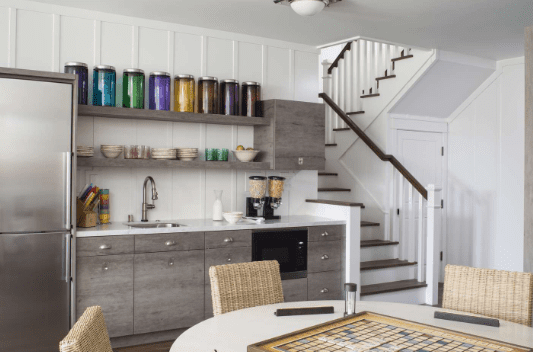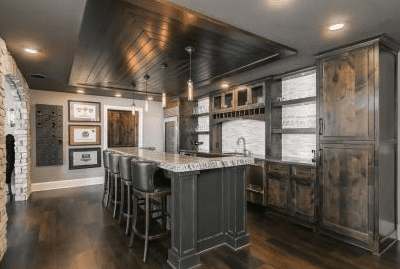There’s something undeniably captivating about Italian culture. The art, the music, the fashion – they all weave together to create a rich tapestry of tradition and innovation. But let’s delve deeper into a lesser-known aspect of Italian life that has puzzled outsiders and intrigued even the most seasoned travelers: the tradition of Italian basement kitchens. Yes, you heard that right – kitchens tucked away in the depths of Italian homes. Join me on a journey as we unravel the mystery behind this fascinating phenomenon.
Historical Evolution of Basement Kitchens in Italy: A Glimpse into the Past
To understand the roots of basement kitchens, we must travel back in time to the ancient Roman era. Imagine the hustle and bustle of those days, where the heart of the home was designed with utilitarian functionality in mind. Ancient Roman homes were not only architectural marvels but also ingeniously designed spaces that combined form and function seamlessly. It’s here that the connection between basement spaces and food storage first emerged. With the lower levels offering cooler temperatures, it was only logical to store food and set up rudimentary cooking spaces there.

The influence of medieval architecture further solidified the concept of basement kitchens. Picture the narrow, winding streets of medieval Italian towns. Limited space in these urban centers sparked architectural creativity, leading to innovative designs. The challenge of maximizing functionality within confined spaces led to the integration of kitchens in lower levels. This wasn’t just about practicality; it was a testament to the resourcefulness of Italian architects and their deep understanding of how people interacted with their living spaces.
Fast forward to the modern era, and we see urbanization posing new challenges. The sprawling cities of Italy faced issues of space scarcity, and the concept of basement kitchens evolved to address these concerns. However, even in the midst of urbanization, there was a conscious effort to preserve the historical value of basement kitchens. This wasn’t just about architecture; it was about preserving a piece of Italian history and culture.

Practical Reasons for Basement Kitchens: Where Form Meets Function
Ah, the sweet aromas of Italian cooking – they can transport you straight to the heart of Italy. But those strong aromas come with their own set of challenges. Traditional Italian cooking methods often involve the use of robust ingredients that fill the air with irresistible fragrances. Basement kitchens were a practical solution to manage these scents, keeping the living areas above fresher and cooler. In the sweltering heat of Italy, this was a game-changer.
Optimizing space has always been a priority in compact Italian households. With multifunctional spaces at the core of Italian home design, basement kitchens offered a seamless solution. The challenge of accommodating daily activities in small living spaces paved the way for these innovative kitchen setups. The basement kitchens served as a response to the puzzle of making every square inch count.
But it wasn’t just about space. Basement kitchens enhanced social dynamics within families. By separating the cooking area from the formal living spaces, these kitchens created an intimate environment perfect for family gatherings. The clinking of pots and pans, the laughter, and the joy of creating meals together – these are the moments that strengthen family bonds and make memories that last a lifetime.

Cultural Significance and Traditions: A Delectable Blend of Past and Present
Food is the soul of Italian culture. Family meals are more than just a routine; they’re a cornerstone of Italian identity. The connection between food, family, and community is deeply ingrained in the Italian way of life. Basement kitchens play a pivotal role in this cultural tapestry, acting as a hub for family interactions. They become spaces where culinary traditions are lovingly passed down from one generation to the next.
The symbolism of basement kitchens goes beyond the practical. They pay homage to ancestral practices while embracing modernity. These kitchens are a visual representation of how Italians respect and honor their roots, even as they adapt to contemporary living. It’s a beautiful blend of the past and the present, all embodied in the architectural choices made within the home.
Contemporary Interpretations and Adaptations: Balancing Heritage and Change
As we find ourselves in the 21st century, the landscape of family dynamics has shifted. Busy schedules and changing lifestyles have presented new challenges. Yet, the essence of basement kitchens persists. Families have found ways to adapt this tradition to modern life. While some might argue that the pace of life has changed, the need for familial connections remains unaltered.

Preservation efforts and architectural innovations are helping restore historical basement kitchens in renovated homes. Blending traditional designs with contemporary aesthetics, these kitchens are a testament to the importance of preserving cultural heritage while embracing the future. They’re more than just rooms; they’re statements of identity and belonging.
Italian Basement Kitchens Are More than Just Kitchens, It’s a Way of Life
As we wrap up our journey into the world of basement kitchens in Italian homes, it’s clear that they encapsulate more than just a practical solution. They’re a reflection of the essence of Italian culture, where family, food, and tradition converge. The evolution of these kitchens from ancient Rome to modern Italy speaks volumes about the adaptability and resilience of Italian society.
So, the next time you find yourself wandering the charming streets of Italy, take a moment to appreciate the basement kitchens that lie beneath those quaint homes. These spaces are a living testament to the interconnectedness of history, culture, and architecture. And as we celebrate the past while embracing change, let’s remember that these basement kitchens aren’t just architectural curiosities – they’re a way of life.

